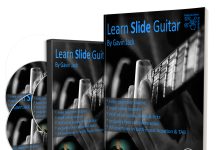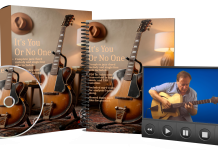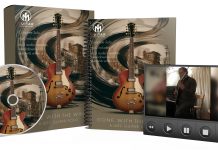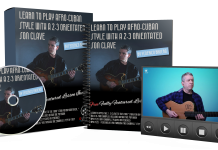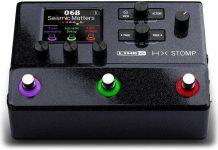This post may contain affiliate links. As an Amazon associate, Google associate as well as associate for other programs, Guitar & Music Institute may earn commissions from qualifying purchases.
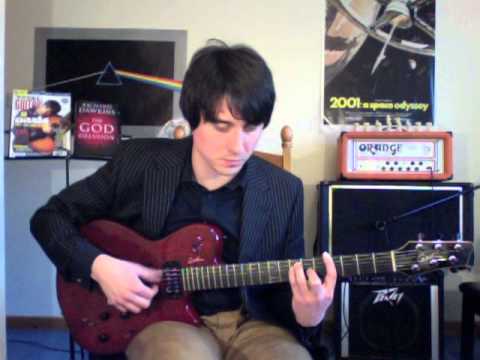
Embark on a musical journey that elevates your guitar prowess by learning to play guitar barre chords. The mastery of bar chords guitar technique is not just a rite of passage for budding musicians, but a strategic tool that unlocks the full potential of your fretboard. As barre chords for beginners may seem daunting, remember that every expert guitarist was once a novice. Your hands are about to discover the versatility and harmonic richness that barre chords bring to your playing, transforming the way you navigate through melodies and chord progressions.
Beginning with a single shape and moving it along the neck, barre chords enable you to play in any key with ease. This adaptability is at the heart of why barre chords are essential. Whether learning online or in-person, proper technique is your secret weapon. Incorrect hand positioning or insufficient practice can lead to frustration, but with daily dedication, you’ll quickly turn discomfort into a display of dexterity on the strings. Be patient, persevere, and soon you’ll witness your hard work paying off, chord by chord.
Key Takeaways
- Barre chords offer the ability to play in various keys and enhance musical versatility.
- Proper technique is key for learning barre chords, especially when self-teaching.
- Regular, targeted practice is essential for overcoming the initial learning curve.
- Patience and persistence are your allies on the journey to barre chord proficiency.
- Barre chords can feel challenging at first, but are integral to becoming a well-rounded guitarist.
Unlocking the Basics of Bar Chords Guitar
As you embark on a quest to make playing barre chords an effortless part of your guitar repertoire, it’s pivotal to demystify the elements that construct these versatile chord structures. Notoriously perceived as a hurdle for many, the technique of pressing down multiple strings with a single finger is, in fact, a gateway to musical freedom on the fretboard.
Defining Barre Chords and Their Versatility
What exactly sets barre chords apart? They’re ingenious in their simplicity: You literally bar across the guitar neck, transforming a single chord shape into a passport to any key. By mastering the barre chord, you’ve equipped yourself with the key to barre chords up the neck, unlocking chords of multifarious names and sounds. Such fluency is indispensable, especially when transposing songs swiftly during live performances or jam sessions.
The Key To Utilizing Barre Chords Across the Fretboard
The transcendence of barre chords made easy isn’t just a slogan—it’s your reality with the right approach. The beauty of these chords lies in their ability to adapt and thrive across genres. From the cozy coffee shop acoustic sessions to the electrifying ambiance of rock concerts, your command over barre chords echoes in every note. Their portability across the fretboard means versatility at your fingertips, and it’s your time to harness this power.
Avoiding Common Mistakes When Playing Barre Chords
As you seek bar chord help, it’s important to identify and correct common mistakes that can hinder your progress. One of the first hurdles to tackle is the positioning of your thumb, palm, and wrist. It’s all too easy to adopt a grip that feels natural but is actually detrimental to playing barre chords effectively. Let’s delve into the subtleties of correct hand positioning that can take your playing from muddled to melodious.
Your journey through bar chord lessons for beginners will likely underscore the significance of your thumb’s location. Contrary to the instinctive habit of hooking your thumb over the guitar’s neck, barre chords demand a different approach. By placing your thumb firmly on the back of the neck, you create a supportive anchor, allowing your index finger to stretch conveniently across the strings.
Bar chord tips often suggest scrutinizing your wrist posture as you practice. The goal here is to position your wrist just below the neck, minimizing bending to maximize the strength and stability of your hand. It might take a bit of adjustment, but maintaining a straighter wrist fosters endurance and cleaner chord transitions without the strain.
Another crucial tactic in mastering barre chords is to reevaluate your elbow position. Banish the ‘chicken wing’ approach—where your elbow strays far from your body—by dropping your arm and keeping your elbow at a closer and more relaxed distance. This not only aids in applying sufficient pressure with the index finger but also reduces the overall fatigue you might feel during extended play.
Last but not least, let’s emphasize the index finger—the powerhouse of the barre chord. The secret lies in using the firmer edge of your finger, instead of the softer front, to press down on the strings. This subtle shift provides the necessary pressure without demanding Herculean strength, and with this minor tweak, your chords will resonate with newfound clarity.
By mindfully addressing these aspects with patience and practice, you will find that barre chords become less of an obstacle and more of an exciting feature of your guitar prowess. So stay steadfast in refining your technique; your efforts will soon harmonize into musical eloquence on the fretboard.
Learning To Play Guitar Barre Chords: Hints & Tips
Embarking on the journey of barre chords practice is both thrilling and challenging, particularly for those new to the guitar. As you start your ascent towards barre chord proficiency, there are steps that can ease the initial incline, making the process more approachable and rewarding. Let’s explore a couple of strategies tailored for beginner and intermediate players eager to perfect their technique on both acoustic guitar barre chords and electric guitar bar chords.
Starting with Simpler Barre Chord Positions
Avoid the common pitfall of jumping straight into the deep end with chords like the F barre chord. Its proximity to the nut means your fingers will need to exert more force, making it a formidable first challenge. Instead, ease into your barre chords practice with positions that are friendlier to your fingers. Consider the five-string minor barre chords at the seventh fret, or transition to six-string major bar chords also placed in the seventh position. These are not only simpler to hold down but will help you build the foundational strength and muscle memory for more complicated shapes in the future.
Adjusting Your Guitar Action for Easier Playability
No amount of practice will override the struggle of an improperly set up guitar. High action is a common barrier, which demands unnecessary pressure to fret the notes clearly, and can quickly lead to fatigue and frustration. Take the time to adjust the action, ensuring it complements your play style and provides a comfortable path to mastering acoustic guitar barre chords made easy. This adjustment can make a substantial difference in your barre chords practice sessions, allowing you to focus on perfecting your technique rather than battling with your instrument.
Optimizing Fingering Techniques for Clean Barre Chords
Perfecting your barre chord finger technique is crucial to enhancing the clarity and resonance of each chord you play. Adjusting your thumb, index finger, and elbow placement isn’t just a suggestion—it is essential for mastering the best way to practice barre chords. Whether you’re working on the rich tones of 5 string barre chords or the full six-string grip, these adjustments will be transformative.
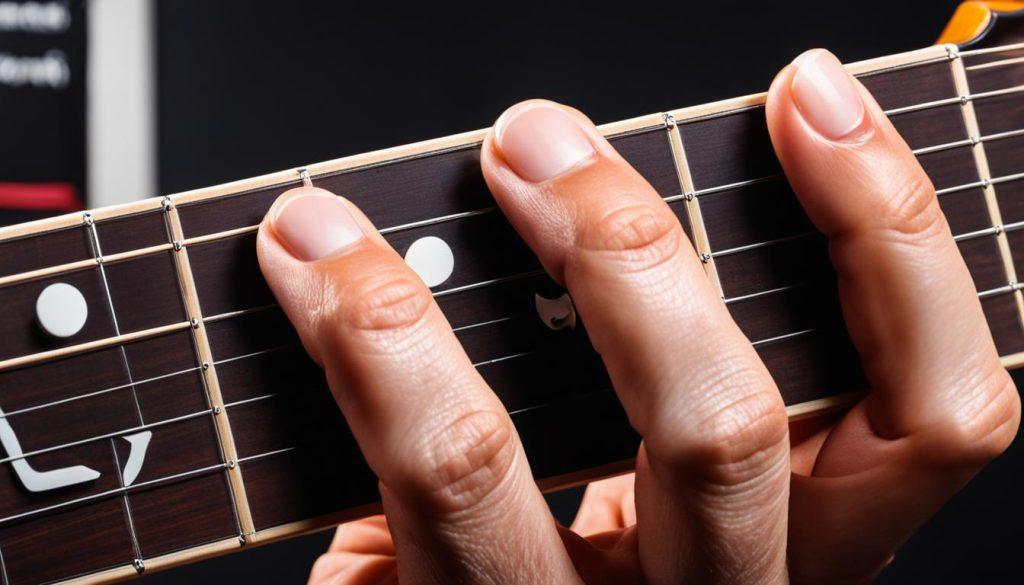
Finding the Right Thumb Position for Maximum Comfort
One of the foundational steps in your barre chord journey is finding the right thumb position. Place your thumb halfway down the back of the guitar neck, which allows your wrist to settle into a more comfortable, lower position. This will enable you to apply even pressure across all strings with your index finger, making your barre chords ring true with each strum.
Using the Side of Your Index Finger for Improved Pressure
To best leverage the strength of your barre chord finger, utilize the harder, bony side of your index finger. Compared to the soft, fleshy part, the side alignment can vastly improve the pressure you exert, leading to cleaner and more distinct notes. Remember to keep your elbow close to your body—this will naturally encourage proper finger positioning adjacent to the fret, which is key for a well-formed barre chord.
As you continue to refine these techniques, you’ll discover that the journey of playing barre chords becomes a less daunting and more rewarding experience. With persistence and mindful practice, your fingers will soon navigate the fretboard with precision and ease.
Six Barre Chords Shapes You Should Definitely Learn
Mastering Barre Chords for Beginners with Proper Hand Posture
For those embarking on their musical ventures, barre chords for beginners might appear as a steep hill to climb, especially if you’re dealing with bar chords for small hands. However, fret not, for with proper hand posture and a few strategic tips, you’ll be strumming these chords with grace, perhaps even with the elegance of barre chords classical guitar style. So let’s dig into the particulars that will pave your path to success.
First and foremost, let’s conquer that thumb placement. Your thumb isn’t just there for support; it is the unsung hero behind your barre chord pressure. A well-positioned thumb on the back of the guitar neck creates the foundation for your fingers to generate enough pressure on those strings, making each barre chord full and vibrant. Keep it centered, relatively parallel to the index finger, and watch as it steadies your hand.
Next, angle your index finger just right. Avoid at all costs the dreaded “chicken wing”, where your elbow wings out, distancing itself from your body—it’s a classic mistake. Instead, imagine your hand as an extension of your arm, close and relaxed by your side. This alignment will enable your index finger to rest, not strain, across the strings, creating that neat, crisp bar you’re aiming for.
Remember, the wrist is not just a connector—it’s a pivoting point that requires attention. Keep your wrist as low as comfortably possible, ensuring a minimal bend. This is not just a visual cue but a practical approach to avoid stress and maintain a relaxed posture, key to your hand’s endurance and ultimately to your chords sounding clear and consistent.
But let’s not ignore the bigger picture: the role of your arm. Arm strength plays a considerable part in sustaining the barre chord shape. By pulling back ever so slightly with your fretting arm, you relieve some of the burden placed on your hand and thumb, ensuring a more effortless, efficient hold on those chords. This practical tip could be a game-changer for those with bar chords for small hands.
It’s a symphony of movements: the thumb’s steadfastness, the index finger’s precise pressure, the elbow’s proximity to the body, and the arm’s subtle strength—all these coalesce into a perfect harmony that produces clear, sustained barre chords. Keep practicing this choreography of posture, and the music you’ll make will resonate with the confidence of your newfound technique. So tune up, dive in with determination, and let those barre chords ring!
Progressing to Complex Bar Chords Guitar Shapes
As your journey in guitar mastery continues, you’re now ready to delve deeper into the realm of complex bar chords guitar shapes. You’ve got a solid grip on basic forms, and it’s time to broaden your horizons. Entering this new phase, you’ll encounter a variety of new voicings and shapes that will enrich your playing and add sophistication to your repertoire. Let’s explore the path from the foundational shapes to advanced guitar wizardry.
From Basic 5th String Barre Chords to Advanced Voicings
The logical next step after conquering the essential barre chords is to transition to 5 string barre chords, which open up a new spectrum of musical possibilities. These chords are uniquely adaptable and offer a gateway to exploring new musical pathways. Begin to familiarize yourself with fifth string root notes, and you’ll soon be fluent in playing 5th fret bar chords that harness the power of voicings previously unattainable. The 4th fret barre chords might have seemed out of reach when you started, but with practice, they become vital components of your expanding musical toolkit.
Utilizing ‘CAGED’ System to Expand Barre Chord Vocabulary
Once you’re comfortable with the essentials of 5th string barre chords and the variations around the 4th and 5th fret, it’s time to use the ‘CAGED’ system to revolutionize your understanding of the fretboard. This venerable guitar theory tool takes the open chord shapes of C, A, G, E, and D – hence ‘CAGED’ – and repurposes them into movable barre shapes. By mastering this system, you’ll fluidly navigate across the neck, enhancing your ability to creatively express in any key, any style. You’ll find that this approach not only broadens your chord vocabulary but deepens your comprehension of music theory and its practical applications on the guitar.
Amplifying Your Barre Chord Practice with Muscle Memory Exercises
Developing proficiency in barre chords is akin to learning a language—repetition is the bedrock upon which fluency is built. In your quest to find the best way to learn barre chords, integrating muscle memory exercises into your practice routine is essential. Like the strongest of steel is forged through the fire of consistency, your fingers, too, will become adept at creating the precise shapes and pressures needed for barre chords through persistent training. Let’s break down how deliberate repetition and structured exercises are your most reliable tools in shaping your barre chord skillset.
The Role of Repetition in Barre Chord Proficiency
When you engage in bar chords practice, you’re doing more than just playing notes. You’re ingraining a physical language into your fingers, allowing them to dance across the fretboard with grace and confidence. Visualize each repetition as a chisel, with which you sculpt your muscle memory to perfection. With each pass, the movements required for the best way to play barre chords become embedded in your psyche, ready to be summoned without a second thought.
Effective Practice Routines for Strengthening Barre Chord Grip
How often have you wondered if there’s a method to rapidly progress from fumbling to fluid in your barre chords practice? The best strategies employ a clear structure—a roadmap of exercises designed to build the strength of your grip and accuracy of your finger positioning. Dedicate time to isolate each barre chord shape within your sessions, and you will find the transition between these shapes becoming seamless. A daily regimen that targets these areas specifically ensures that the intricate ballet of your fingers becomes a natural, effortless motion—propelling you towards impeccable barre chord execution.
Barre Chord Shapes You Should Definitely Know
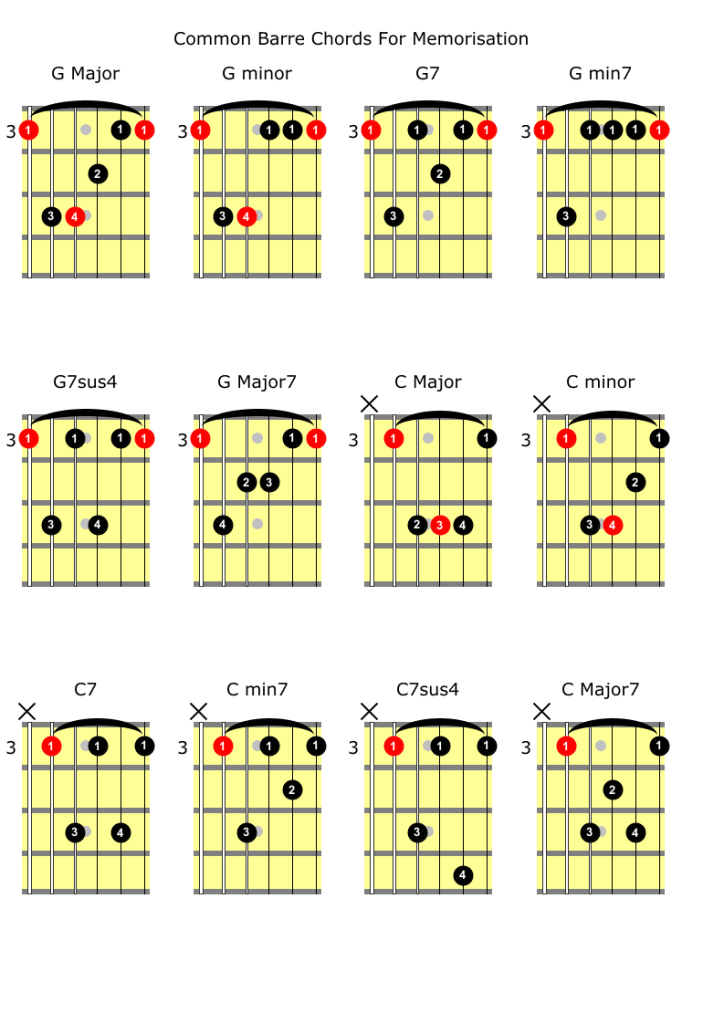
Easing the Pain: Barre Chords for Small Hands
If you’re struggling with barre chords for small hands, you’re not alone. Many guitar players find that the wide stretch and the strength required can seem daunting. But don’t be discouraged—there are ways to make barre chords easy. Your size should never be a barrier to mastering these essential chords. Here are some personalized barre chord lessons for beginners to help you play without pain or discomfort while still achieving the clear, resonant notes you aim for.
Firstly, focus on your elbow position. Keep it close to your body to reduce the strain on your fingers and wrist. Much like a painter steadies their brush hand, anchoring your elbow helps to control the movement and pressure you need to exert across the fretboard.
The next step is to ensure your thumb is properly aligned. It should rest comfortably against the back of the guitar’s neck, allowing your hand to form the barre chord shapes with greater ease. This might require a bit of experimenting to find the most comfortable thumb position that provides both support and flexibility.
Another essential tip is to use the edge of your index finger rather than the flat part when forming the bar. This part of your finger is firmer, allowing you to apply the necessary pressure without having to squeeze too hard. It’s a simple shift that can make a world of difference to the sound and feel of your barre chords.
Finally, don’t forget the importance of finding comfortable positions on the guitar neck. This might mean starting with barre chords that are higher up the neck, where the frets are closer together, and gradually working your way down as you build strength and confidence.
Remember, mastering barre chords for small hands is within your reach. Every practice session brings you a step closer to smooth, pain-free playing. Stay patient, stay determined, and those once challenging bar chords will become natural and easy to execute. Keep these tips in mind, and let’s hear your guitar sing!
Addressing Barre Chords with Muted Strings and Troubleshooting
When you’re strumming along and a chord doesn’t ring out clearly, it’s all too common to encounter the frustration of muted strings within your barre chords. Before you let it dampen your guitar-playing spirits, let’s tackle this common issue together and ensure every note in your chords shines through.
Common Causes of Barre Chord Buzzing and How to Fix Them
Sometimes, despite your efforts, you might hear a buzz or find that some strings remain stubbornly silent. If you’re experiencing barre chords muted strings, know that you’re not alone—this is a common bar chords challenge that many guitarists face. One main culprit can be insufficient pressure applied to the strings. This is often a matter of building up the necessary finger strength over time, which will come with practice. It’s also crucial to adjust your technique to avoid improper finger placement, which can lead to buzzing strings.
To remedy this, focus not on brute force, but on the precision of your index finger’s placement. Ensure it’s kept straight and slightly rolled onto its side, using the edge that’s closer to the bone. This enables you to apply more focused pressure without the fatigue that comes from trying to flatten your finger across the fretboard.
Adjusting Finger Positions to Ensure All Notes Ring Clear
Aside from working on strength and technique, adjusting bar chords can sometimes be as straightforward as a slight shift in finger position. Your barre should be as close to the fret as possible, without being on top of it, to facilitate easier string depression and clearer sound. If a particular string in the barre chord is buzzing or muted, try shifting your finger up or down ever so slightly to avoid natural creases in your skin, which can cause issues.
The action on your guitar can also impact the clarity of your barre chords. If the strings are too high off the fretboard (a high action), they require more pressure to make clean contact with the frets, which can be especially challenging when playing barre chords. If adjusting your technique doesn’t solve the problem completely, it might be worth having a professional look at your guitar’s setup. By lowering the action, your fretting fingers won’t have to work as hard, which makes playing barre chords much more comfortable—and your chords will sound clearer, too.
Some Chord Progression Examples Using Barre Chords
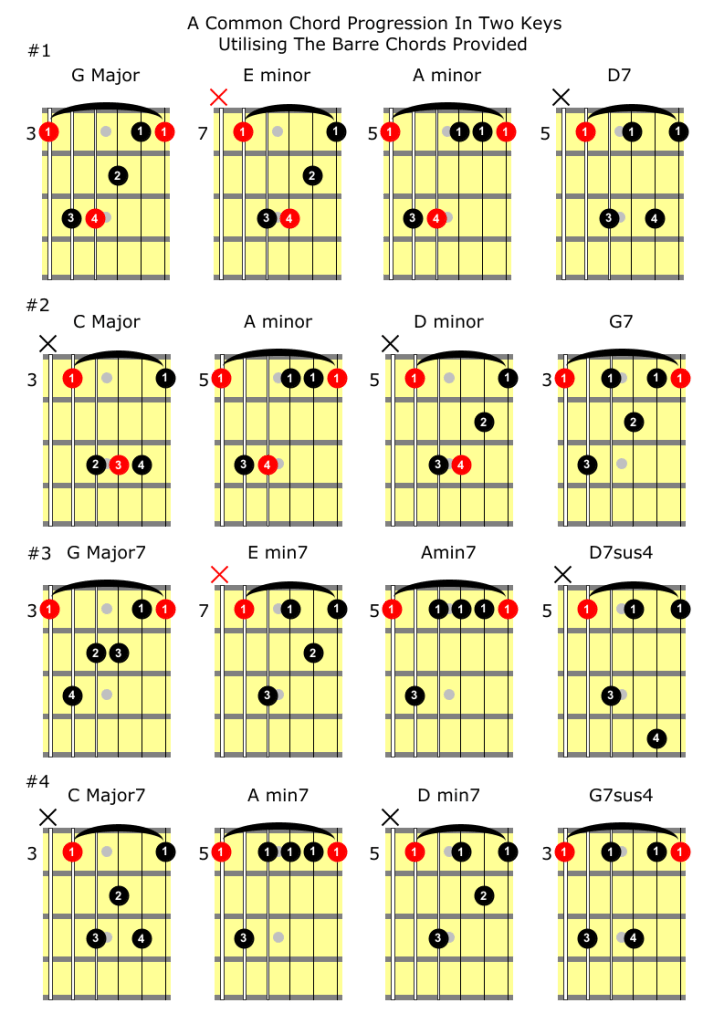
Barre Chords on Acoustic vs. Electric Guitars
When venturing into the realm of barre chords, the type of guitar you wield greatly influences your technique and sound. Whether you’re caressing the strings of an acoustic or the sleek neck of an electric, understanding the nuances between the two can empower you to adapt and play with ease.
How Guitar Types Influence Barre Chord Techniques
The battle for clarity in sound is often fought with the pressure of your fingers, and nowhere is this more evident than in the world of acoustic guitar barre chords. Due to higher string action and the heftier gauge of strings, acoustic guitars demand a firmer touch. Conversely, the svelte strings of electric guitar bar chords dance to a lighter touch owing to their characteristically lower action.
Modifying Barre Chord Pressure for Different String Actions
Whether setting the mood with acoustic bar chords in an unplugged session or harnessing raw energy with electric ones in a high-octane gig, adjusting your finger pressure is key. It’s not just about pressing harder or softer; it’s about the fine art of modifying your touch. This subtlety can make the difference between a muffled note and a pitch-perfect chord — it’s the signature of a skilled guitarist.
Incorporating 5th Fret Bar Chords into Your Playing
Enhancing your guitar skills involves bridging the gap between open and bar chords, and the 5th fret is a significant milestone on this musical journey. Integrating 5th fret bar chords can transform your playing, providing a smooth transition that enriches your understanding and execution of music on the guitar. Embrace these chords, and you’ll soon appreciate their role in creating more complex and sonorous melodies.
Transitioning Between Open and Barre Chords at the 5th Fret
When you begin incorporating 5th fret barre chords into your practice routine, you’ll notice a new realm of fluidity taking shape. These shapes serve as a bridge, allowing you to seamlessly switch between the comforting familiarity of open chords and the robust versatility of barre chords. As you master these transitions, your chord progressions can take on more depth, enhancing the emotive quality of each piece you play.
Understanding the Importance of the 5th Fret in Bar Chord Progressions
The 5th fret isn’t just a position on your guitar; it’s a launchpad from which countless songs and chord progressions take flight. Whether you’re anchoring 5th string barre chords or extending the range of your harmonies, the 5th fret plays a critical role. It’s where you’ll often find the root notes that anchor your music, making your progressions resonate with intention and clarity.
As you delve deeper into the dynamic world of 5th fret barre chords, you’ll develop not just muscle memory, but also an intuitive feel for the fretboard’s geography. Each strum at the 5th fret marks a note in your ever-expanding musical vocabulary, allowing your creativity to flourish and your expression to resonate with every listener.
Exploring Altered Tunings: Breaking Boundaries with Barre Chords
As you continue to evolve as a guitarist, you may find yourself yearning for new musical vistas. One way to satisfy this creative thirst is by venturing into the world of altered tunings guitar styles. With altered tunings, the familiar landscape of the fretboard changes, offering a fresh perspective on barre chords and the music they can create.
Adapting Barre Chord Shapes for Alternative Tunings
The transition to altered tunings requires a flexible approach to the barre chord shapes you’ve come to know. As the intervals between the strings shift, so too must your finger placements. This adaptation can be an exciting challenge that pushes the limits of your technical skills and rewards you with unique chord voicings. You’ll discover that open tunings barre chords might need a slight twist or compression of your typical shapes to fit the new sonic landscape.

Discovering New Soundscapes with Open and Drop Tunings
Embracing open tunings can lead to an exploration of soundscapes previously unexplored. In these tunings, your guitar resonates differently, producing rich overtones and harmonious open chords that can be enhanced with barre chords. Similarly, drop tunings barre chords allow for heavier, more resonant sounds often found in contemporary rock and metal genres. Whichever path you choose, these tunings invite you to expand your musical palette and step outside of the traditional chord shapes and progressions.
From GMI – Guitar & Music Institute: Insights into Barre Chord Mastery
The journey to mastering barre chords is filled with rich insights that not only elevate your guitar playing but also imbue you with an appreciation for the intricate beauty of the guitar. At GMI – Guitar & Music Institute, professional guitarists and educators bring forth a wealth of knowledge, empowering you with guitar techniques that have shaped the sounds of countless songs and genres.
Learning from the Pros: Techniques and Philosophies
As you delve into the GMI online courses on barre chords, you’ll gain access to the wealth of techniques that professional musicians use. You’ll learn more than just the physical aspects of playing; you’ll absorb the philosophies that have guided the fingers of the experts across fretboards throughout history. It’s not just about where you place your fingers—it’s about understanding why you’re doing it and how it contributes to your overall musical expression.
Online Courses for Furthering Your Barre Chord Skills
With GMI’s comprehensive online courses, your ability to play barre chords will transform from a tentative effort to a confident display of musical proficiency. Each lesson is a step towards conquering common challenges and mastering a variety of chord types and progressions. Whether you’re an acoustic aficionado or an electric guitar enthusiast, these tailored courses will provide you with the means to take your barre chord skills to new heights. Embrace the challenge, enjoy the learning process, and watch as your fretboard becomes a playground for musical exploration.
Conclusion: Navigating the Fretboard to Barre Chord Brilliance
The road to mastering barre chords is marked by the perseverance and resolve of the player, embodying both the spirit and the technical demand of guitar mastery. It’s a journey wrought with challenges but equally rich in rewards, offering an extensive palette of harmonies and the joy of playing advanced barre chords with ease. Along this musical expedition, every strum brings you closer to an intricate dance of harmony and progression, culminating in a comprehensive command of your instrument.
Your ambition to flawlessly transition between chords, potentially perfecting guitar chord changes, requires a consistent and patient practice regimen. By integrating the essential tips and techniques discussed, from hand posture refinement to dexterous finger placement, your barre chord fluency will see a remarkable transformation. Whether your path leads you through the melodic nuances of an acoustic guitar or the electrifying pulses of an electric one, your adaptability and skill growth will resonate with every note played.
Unlock the full potential of your fretboard and embolden your musical expressions by incorporating the expansive world of barre chords into your daily play. A disciplined approach coupled with the wealth of knowledge discussed throughout our article will undeniably advance your guitar prowess. As you continue to evolve and refine your barre chord technique, remember that the strings under your fingers are not just a part of the guitar; they are the conduits to an enriched musical voice awaiting the world’s audience.
FAQ
What exactly are barre chords and why are they versatile?
Barre chords are a type of guitar chord where one finger presses down on multiple strings across the fretboard. They are versatile because they allow you to play chords in any key, making it possible to transpose songs and play a wide variety of music without having to learn new chord shapes.
How do I start learning to play guitar barre chords?
Start by practicing simpler barre chord positions, such as the 5th string minor bar chords or 6th string major bar chords, around the 5th or 7th frets where the strings are easier to press down. Focus on correct finger placement, wrist alignment, and thumb position to build a solid foundation.
What techniques can I use to make playing barre chords easier?
To make barre chords easier, ensure your guitar action is adjusted for comfortable playability. Practice using the side of your index finger to apply pressure, maintain a healthy thumb position at the back of the neck, and keep your wrist straight to help with applying consistent pressure across the strings.
What are common mistakes to avoid when playing barre chords?
Avoid positioning the thumb too high on the neck, bending the wrist excessively, and having the “chicken wing” elbow position. Also, ensure your index finger is straight and close to the fret, which will help prevent buzzing and muted strings.
How can I progress to more complex barre chord shapes and voicings?
After becoming comfortable with basic barre chords, you can progress to more complex shapes by practicing the ‘CAGED’ system and exploring barre chords up the neck. This expands your chord vocabulary by utilizing familiar open chord shapes as templates for new barre chord positions.
Why is repetition important in learning barre chords?
Repetition is crucial as it helps develop muscle memory, making it easier to form barre chords quickly and with less effort over time. A consistent practice routine focusing on these chords will also strengthen your hand and arm, aiding in smoother transitions between chords.
Can I play barre chords with small hands?
Yes, even if you have small hands, you can play barre chords. Adjusting your elbow closer to your body, ensuring proper thumb placement, and experimenting with angles and positions can make these chord shapes more manageable, and practice will help you find techniques that work for your hand size.
How do I deal with buzzing or muted strings when playing barre chords?
To address buzzing or muted strings, ensure you’re applying enough pressure with your index finger, keeping it straight and rolling it slightly to use the bony edge. Also, check your guitar’s setup because a high action can make barre chords more difficult to play cleanly.
Does the type of guitar I use affect how I play barre chords?
Yes, the type of guitar can affect barre chord playability. Acoustic guitars usually require more finger strength than electric guitars due to higher action and thicker strings. You may need to adjust your technique and the amount of pressure you apply based on your guitar type.
Why is the 5th fret important when learning barre chords?
The 5th fret is a great place to start when transitioning from open chords to barre chords. It helps you understand where the root notes are located on the 5th and 6th strings and offers easier grip strength requirements, which is beneficial for practicing chord changes and progressing your skills.
How can altered tunings influence my barre chord playing?
Altered tunings like open or drop tunings change the intervallic relationships between the strings, meaning you’ll have to adjust barre chord shapes to compensate. This can introduce creative new sounds and enhance your versatility as a guitarist.
Where can I find resources to improve my barre chord techniques?
Resources for improving your barre chord techniques can be found through online courses at schools like GMI – Guitar & Music Institute, where you can learn from professionals and experienced educators. Various online tutorials, websites, and books are also available to help refine your playing.
Source Links
- https://www.guitarnoise.com/lessons/tips-for-mastering-barre-chords/
- https://www.stringkick.com/blog-lessons/barre-chords/
- https://josephbrenna.com/guitar-lessons/the-secret-to-mastering-barre-chords-on-guitar/
This post may contain affiliate links. As an Amazon associate, Google associate as well as associate for other programs, Guitar & Music Institute may earn commissions from qualifying purchases.





